
|
Historical Approach to Physics according to Kant, Einstein, and Hegel
-
Y. S. Kim
Center for Fundamental Physics, University of Maryland,
College Park, Maryland, 20742, U.S.A.
Abstract -- It is known that Einstein's conceptual base for his theory of relativity was the philosophy formulated by Immanuel Kant. Things appear differently to observers in different frames. However, Kant's Ding-an-Sich leads to the existence of the absolute reference frame which is not acceptable in Einstein's theory. It is possible to avoid this conflict using the ancient Chinese philosophy of Taoism where two different views can co-exist in harmony. This is not enough to explain Einstein's discovery of the mass-energy relation. The energy-momentum relations for slow and ultra-fast particles take different forms. Einstein was able to synthesize these two formulas to create his energy-mass relation. Indeed, this is what Hegelianism is about in physics. Isaac Newton synthesized open orbits for comets and closed orbits for planets to create his second law of motion. Maxwell combined electricity and magnetism to create his four equations to the present-day wireless world. In order to synthesize wave and particle views of matter, Heisenberg formulated his uncertainty principle. Relativity and quantum mechanics are the two greatest theories formulated in the 20th Century. Efforts to synthesize these two theories are discussed in detail.
based on an invited presented at the 32nd Congress of the Italian Society of Historians of Physics and Astronomy (Rome, Italy, September 2012). This article has been ArXived. For the follow-up, click here for pdf.
1. Introduction
-
Einstein studied the philosophy of Immanuel Kant during his earlier years.
It is thus not difficult to see he was influenced by Kantian view of the
world when he formulated his special theory of relativity. It is also known
that, in formulating his philosophy, Kant was heavily influenced by the
environment of Koenigsberg where he spent eighty years of entire life.
The first question is what aspect of Kantís city was influential to Kant.
We shall start with this issue in this report.
In Einsteinís theory, one object looks differently to moving observers with different speeds. This aspect is quite consistent with Kantís philosophy. According to him, one given object or event can appear differently to observers in different environments or with different mindsets. In order to resolve this issue, Kant had to introduce the concept of ďDing-an-SichĒ or thing in itself meaning an ultimate object of absolute truth. Indeed, Kant had a concept of relativity as Einstein did, but his Ding-an-Sich led to the absolute frame of reference. Here Kantianism breaks down in Einsteinís theory. Kantís absolute frame does not exist according to Einstein. In order to resolve this issue, let us go to the ancient Chinese philosophy of Taoism. Here, there are two different observers with two opposite points of view. However, this world works when these two views form a harmony. Indeed, Einsteinism is more consistent with Taoism. The energy-momentum relations is different for a massive -slow particle and for a fast-massless particle. Einsteinís relativity achieved the harmony between these two formulas.
This leads us to Hegelís approach to the world. If there are two opposite things, it is possible to derive a new thing from them. This is what Einsteinism is all about. Einstein derived his $E = mc^2$ from two different expressions of the energy-momentum relation for massive and massless particles.
Einstein thus started with Kantianism, but he developed a Hegelian approach to physical problems. Indeed, this encourages us to see how this Hegelianism played the role in developing new laws of physics. For instance, Newtonís equation of motion combines the open orbits for comets and the closed orbits of planets.
If this Hegelian approach is so natural to the history of physics, there is a good reason. Hegel derived his philosophy by studying history. Hegel observed that Christianity is a product of Jewish one-God religion and Greek philosophy. Since Hegel did not understand physics, his reasoning was based on historical development of human relations. It is thus interesting proposition to interpret Hegelís philosophy using the precise science of Physics.
In Secs. 2 and 3, we review how Kantianism was developed and how Einstein was influenced by Kant. In Sec. 4, it is pointed out that Hegelianism is the natural language in understanding physics. In Sec. 5, we examine whether quantum mechanics and relativity can be combined into one theory according to Hegelian approach to the history of physics.
2. Geographic Origin of Kantianism and Taoism
-
Immanuel Kant (1724-1804) was born in the East Prussian city of Koenigsberg,
and there he spent 80 years of his entire life. It is agreed that his
philosophy was influenced by the lifestyle of Koenigsberg.
The city of Koenigbeerg is located at the Baltic wedge between Poland and Lithuania. As shown in Fig. 1, this place served as the traffic enter for maritime traders in the Baltic Sea. In addition, this city is between the eastern and western worlds (Applebaum 1994). However, there are no natural boundaries such a rivers or mountains. Thus, anyone with a stronger army could come to this area and run the place.
| Figure 1. Koenigsberg was a German city along the Baltic coast between Poland and Lithuania. It used to be a meeting place for many people with different viewpoints. This place is now a Russian city called Kaliningrad. China became one country as a collection of many people from different population pockets with different ideas and different lifestyles. |
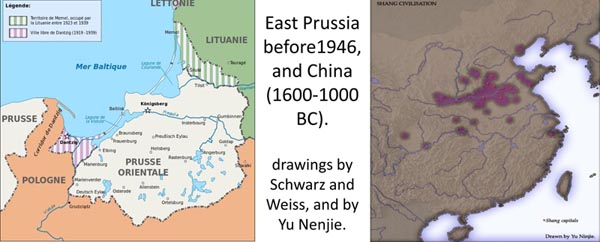
|
Indeed, Koenigsberg was a meeting place for many people with different ideas and different view points. Kant observed that the same thing can appear differently depending on the observerís location or state of mind.
The basic ingredients of Taoism are known to be two opposite elements Yang (plus) and Ying (minus). This world works best if these two elements form a harmony. However, the most interesting aspect of Taoism is that its geographic origin is the same as that of Kantianism. Let us look at the map of China given in Fig 1during the period from 1600 to 100 BC. China started as collection of isolated pockets of population. They then came to banks of the Yellow River, and started to communicate with those from other areas. They drew pictures for written communication leading eventually to Chinese characters.
How about different ideas? They grouped many different opinions into two groups, leading to the concept of Yang and Ying. Immanuel Kant considered many different views, but he concluded that there must be one and only truth.
Indeed, Taoism and Kantianism started with the same environment, but Kant insisted on one truth called Ding-an-Sich, while Taoism ended up with two opposing elements (Kim 2006).
| Figure 2. A Coca-Cola can appears differently to two observers from two different angles. Likewise, the electron orbit in the hydrogen atom should appear differently to two observers moving with two different speeds. |
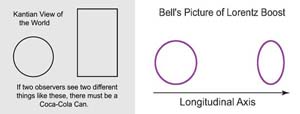
|
3. Kantian Influence on Einstein
-
During his early years, Einstein became quite interested in Kant and
studied his philosophy rigorously. This was quite common among the young
students during his time. Einstein however studied also physics, and got
an idea that one object could appear differently for observers moving
with different speeds.
Let us go to Fig. 2. According Kant, an object or event look differently to different observers depending on their places or states of mind. A Coca-Cola can looks like a circle if viewed from the top. It appears like a rectangle if viewed from the side. The Coca-Cola can is an absolute thing or his Ding-an-Sich. Likewise, the electron orbit of the hydrogen atom looks like a circle for an observer when both the hydrogen and the observer are stationary. If the hydrogen atom in on a train, our first guess is that it should look like an ellipse. This is what Einstein inherited from Kant.
| Figure3. The energy-momentum relation of a particle takes different form when the particle moves with different speeds. Let us choose two limiting cases. Einstein was able to find the same formula applicable to both. In so doing, he found his E = mc 2 . Likewise, the quark model (Gell-Mann 1964) and the parton model (Feynman 1969) should produce a Lorentz-covariant picture of the bound state. |
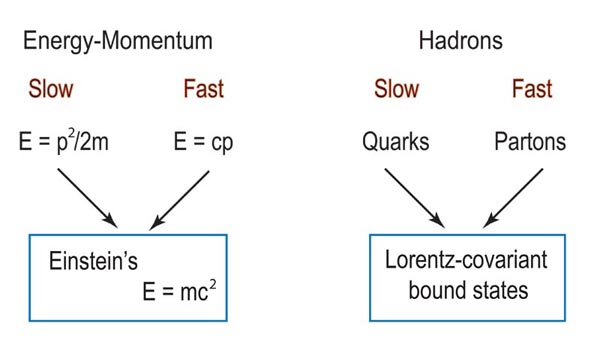
|
However, does the hydrogen atom require a Ding-an-Sich? The answer is No. Indeed, Kant attempted to formulate his theory of relativity with an absolute coordinate system corresponding to his Ding-an-Sich. This is the basic departure of Einsteinism from Kantianism
| Figure 4. Progresses of physical theories are made when two theories are combined into one. The left side of this figure shows how mechanics was developed. The right figure tells how the mechanics and electromagnetism were led to obey the same transformation law. |
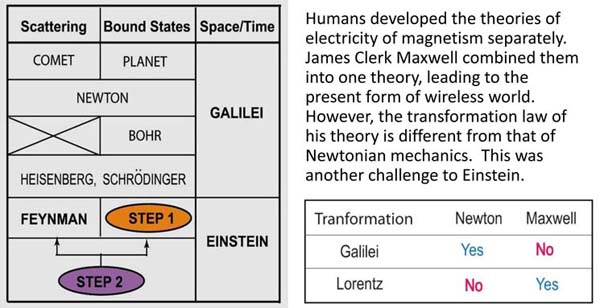
|
Let us come back to Einstein. Like Kant, Einstein started from different observers looking at a thing differently, but ended up with a particle at the rest and the same particle moving with a speed close to that of light. He then derived his celebrated energy-mass relation, as indicated in Fig. 4 (left). Einstein had to invent a formula applicable to both. This is precisely a Hegelian approach to physics. It is not clear whether Einstein knew he was doing Hegel. This remains as an interesting historical problem. As for Einsteinís hydrogen atom, we now have hadrons which are bound states of quarks, while the hydrogen atom is a bound state of a proton and an electron. The proton is a hadron and is a charged particle which can be accelerated to the speed very close to that of light. We shall return in Sec. 5 to the problem presented in the right side of Fig. 3.
However, does the hydrogen atom require a Ding-an-Sich? The answer is No. Indeed, Kant attempted to formulate his theory of relativity with an absolute coordinate system corresponding to his Ding-an-Sich. This is the basic departure of Einsteinism from Kantianism Let us come back to Einstein. Like Kant, Einstein started from different observers looking at a thing differently, but ended up with a particle at the rest and the same particle moving with a speed close to that of light. He then derived his celebrated energy-mass relation, as indicated in Fig. 4 (left).
Einstein had to invent a formula applicable to both. This is precisely a Hegelian approach to physics. It is not clear whether Einstein knew he was doing Hegel. This remains as an interesting historical problem. As for Einsteinís hydrogen atom, we now have hadrons which are bound states of quarks, while the hydrogen atom is a bound state of a proton and an electron. The proton is a hadron and is a charged particle which can be accelerated to the speed very close to that of light. We shall return in Sec. 5 to the problem presented in the right side of Fig. 3.
4. Hegelian Approach to the History of Physics
-
Since Hegel formulated his philosophy while studying history, it is
quite natural to write the history of physics according to Hegel.
First of all, Isaac Newton combined hyperbolic-like orbits for comets
and elliptic orbits for planets to derive his second-order differential
equation which is known today as the equation of motion.
James Clerk Maxwell combined the theory of electricity and that for magnetism to formulate his electromagnetic theory leading to the present world of wireless communication. Max Planck observed that the radiation laws are different for low- and high-frequency limits. By deriving one formula for both, he discovered Planckís constant.
Werner Heisenberg observed the matter appears as a particle also appears as a wave, with entirely different properties. He found the common ground for both. In so doing, he found the uncertainty relation which constitutes the foundation of quantum m echanics.
Indeed, quantum mechanics and relativity were two most fundamental theories formulated in the twentieth century. They were developed independently. The question is whether they can be combined into one theory. We shall examine how Hegelian approach is appropriate for this problem in Sec. 5.
5. How to combine Quantum Mechanics and Relativity
-
Here again, the problem gets divided into scattering and bound state problems.
Quantum field theory was developed for scattering problems, and this theory
is accepted as a valid theory, as is illustrated in Fog. 4.
| Figure 5. Diracís quantum mechanics (1927,1945) and Diracís relativity (1949). If they are combined, it leads to a Lorentz-covariant bound-state picture which produces the quark and parton models are two different limiting cases of one formula, just as in the case of Einsteinís energy-momentum formula. |
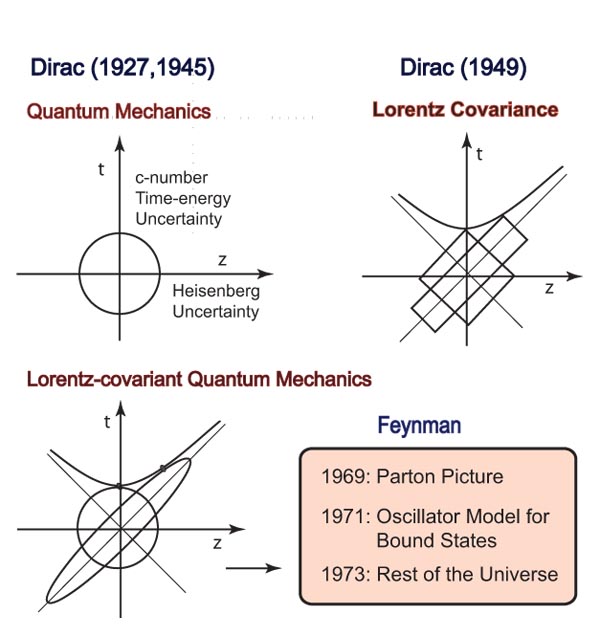
|
For bound-state problems, Paul A. M. Dirac wrote three important papers on this subject (Dirac 1927,1945, 1949). His 1927 paper tells us there is a time-energy uncertainty relation. In 1945, he attempted to use the harmonic oscillator to formulate quantum mechanics applicable to Einsteinís world. If we combine or Hegelize Diracís 1927 and 1945 papers, we end up with the circle given in Fig. 5.
In 1949, Dirac showed the Lorentz boost can be described as a squeeze transformation as shown in Fig. 5. If we Hegelize the circle and the squeezed rectangle, we arrive at the ellipse (Kim and Noz 2011) which can explain what happens in the real world including the quark model (Gell-Mann 1964) and the parton model (Feynman 1969). This Hegelian procedure corresponds to Step 1 in Fig. 4.
The final step in constructing Lorentz-covariant quantum mechanics is to show that the scattering and bound states share the same set of fundamental principles (Han et al. 1981). This Hegelians procedure is illustrated in as Step 2 in Fig. 4.
6. Kant, Hegel, and Einstein
-
Kant and Hegel are two of the most fundamental thinkers affecting
our present-day lifestyles. However, their philosophies were based
largely on social events and applicable to formulation of social
sciences. It is gratifying to note that Einstein gives us a more
concrete picture of their approaches to the problems. By building
the bridge between Kant and Hegel, Einstein
not only gives us the precise description of how physical theories
were developed in the past but also tells us how to approach current
problems in physics.
References
- Applebaum A (1994) between EAST and WEST, across the borderlands
of Europe (Pantheon, New York).
- Dirac P A M (1927) The Quantum Theory of the Emission and Absorption,
Proc. Roy. Soc. (London), vol A114, pp 243-265.
- Dirac P A M (1945) Unitary Representations of the Lorentz Group,
Proc. Roy. Soc. (London), vol A 183, pp 284-295.
- Dirac P A M (1945) Forms of Relativistic Dynamics. Rev. Mod. Phys.,
vol 21, pp392-399.
- Feynman, R. P. (1969) Very High-Energy Collisions of Hadrons.
Phys. Rev. Lett. vol 23, pp 1415-1417.
- Gell-Mann M (1964), Schematic Model of Baryons and Mesons, Phys. Lett.,
vol 8, 214-215
- Han D, Kim Y S, and Noz M E (1981) Physical Principles in Quantum
Field Theory and Covariant Harmonic Oscillators, Found. of Phys. vol 11, 895-903
- Kim, Y S and Noz M E (1977) Covariant Harmonic Oscillators and the
Parton Picture, Phys. Rev. D, vol 15, pp 335-338
- Kim Y S (2006) Einstein, Kant, and Taoism, History and Philosophy
of Physics (physics-hist-ph) arXiv:physics/0604027v1
- Kim Y S and Noz M E (2011) Lorentz Harmonics, Squeeze Harmonics, and their Physical Applications, Symmetry, vol 3, pp 16-36
- Click here
for the power point and other forms of my presentation.
- Click here for
an article written for the proceedings.
- Rome page. If you do not wish to follow my logic, go to may go to Rome page and enjoy this eternal city.
copyright@2013 by Y. S. Kim, unless otherwise specified.